Humming Blog |
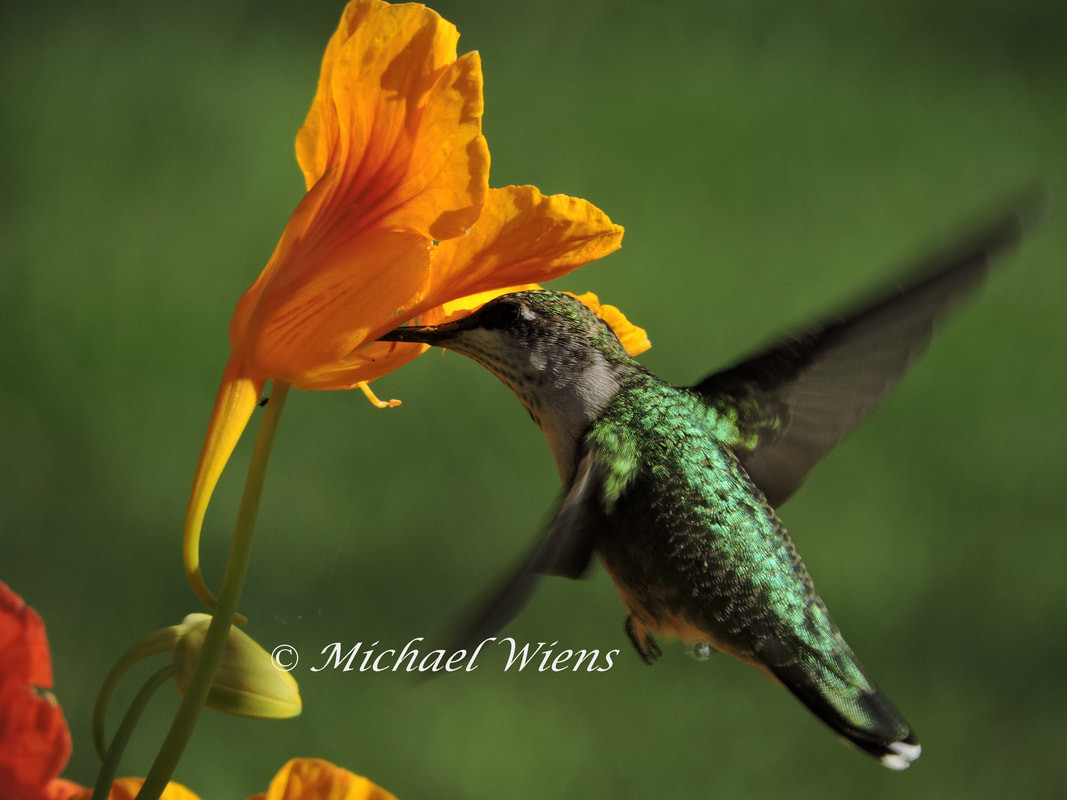 After doing a post the other day on watching hummingbirds migrate, I had a kind lady tell me I'm connected with hummingbirds and seem to know exactly what they're thinking and doing. I think she's the first one to truly recognize what I try to do. I'm not a great photographer, I'm not a hummingbird expert on all the species, but I consider myself more of a hummingbird behaviorist. If I get good captures, it's only because I understand them enough to attract them, and know what they'll do. I like to understand every detail about why they do what they do, to recognize what certain movements mean, and to know these birds as best as humanly possible. I think it's only when we understand their behaviors, will we be able to accomplish the most in attracting them to our gardens. When we know what they really want, we can stand out among the rest and attract more of them to our yard. I've seen well into the millions of sightings now, and there's nothing that I haven't seen. From feeding to flying, mating to fighting, I have watched every movement time and time again. I've analyzed every twitch, itch and quirk within these birds. I've studied and calculated the time of feeding, nesting and incubating. I've invested 16 - 18 hours a day for 15 years, and watched them arrive in Spring to the time they depart in Summer. After that amount of time, I can tell you that many of their behaviors I've seen countless times. No, I haven't gone to school to learn about these birds, I've gone right to the source and learned from them. I've stumbled upon circumstances, and studied them for over 15,000 hours. I've been taught by them, and given knowledge by the one who made them, to get to the place I'm at. Just like those who have learned a profession, this is what I know. It's not prideful, but passion for something I love. I'm always willing to share what I know with those who ask, and not hide information for greed. Is there more to learn, absolutely! As long as this is the direction I'm intended to go, I'll continue to learn and be entertained by one of the most fascinating creatures on the planet. This young male Ruby-throat got a bit creative in feeding from the Nasturtium. They usually stuff their head inside the flower to get the nectar, but this youngster found a way to get the nectar while cheating his part in pollination. August 9, 2019. N.E. of Edmonton, Alberta, Canada.
1 Comment
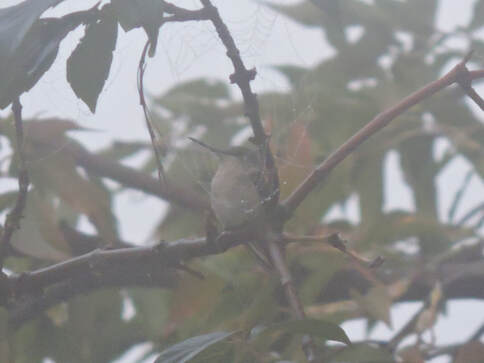 The morning started off with a fog that was heavy and settled deep into the garden. There was complete silence as most migrating songbirds had already moved on. The only thing that appeared to have woken up with the light were a few remaining hummingbirds. Little chasing was going on, but the feeding was regular with resting intervals in between. They continued to feed until the sun burned away the fog.The signs were obvious every time one would visit the feeder. The length of feedings extended well beyond the normal times, and the efforts weren't wasted on fighting. They had received their calling and warmer temperatures awaited them an entire continent away. For over a week now I've watched many hummingbirds arrive and depart from our garden, as our regulars became of age to make the journey, and migrants would stop in for a fill-up before moving on. As of August 24th, I had about 6 hummingbirds to start the morning, but watched a couple of them migrate. As they'd leave, another bird was willing to step into its place and claim the unguarded feeder. This female Ruby-throat sat quietly atop the Lilac bush, disguised behind a sagging spider web soaked in fog. It was only a matter of hours before she too would depart. N.E. of Edmonton, Alberta, Canada. August 24th, 2019. 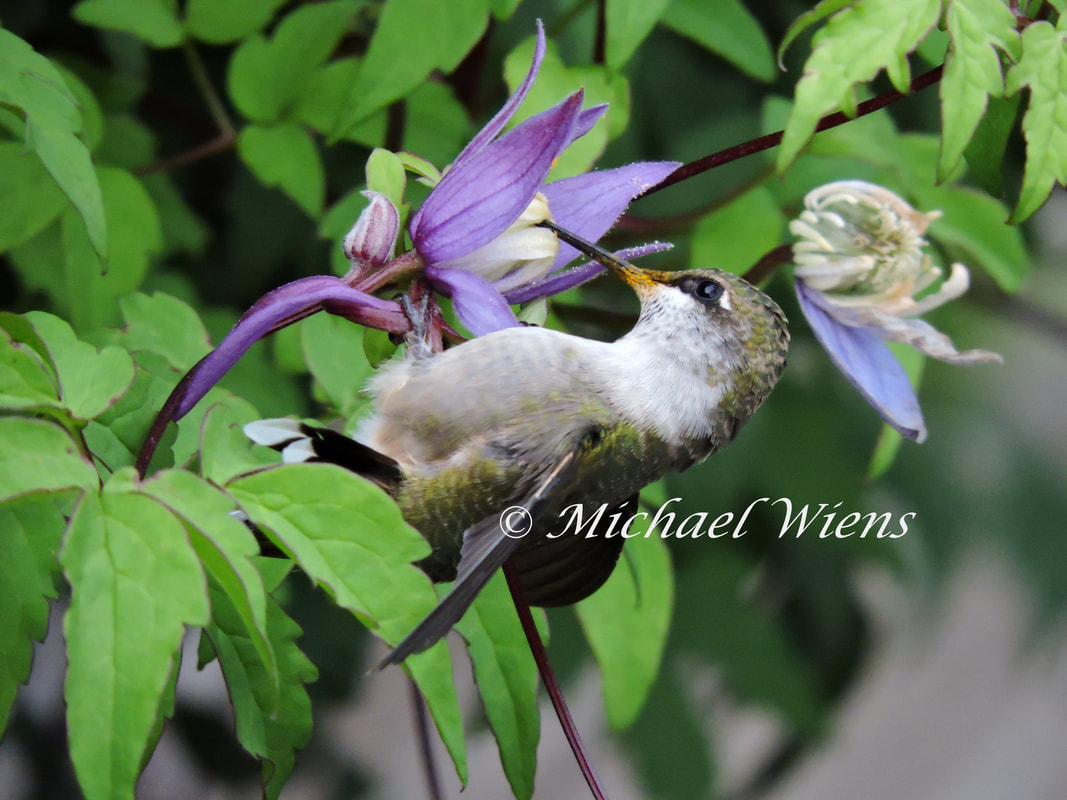 From the moment they spring from the nest, a plan is laid out for each one of them to amuse and entertain thousands of people throughout their lifetime. A vivid story remains in my mind from so many of them that have made our garden home over the last 15 years. From Little Miss, who taught me an incredible amount about their nesting, to the female that made her way through the dense fog, and traveled 10 miles every hour just to gather nectar for her young. Then there's a long line of males that were responsible for producing famous Ziggy, who himself has produced many stories to entertain myself and so many others. And then there are the thousands of young that have shown up with their quirks, squeaks, and antics to constantly produce an abundance of unforgettable moments over the years. This is just my garden, but there are thousands of people across the continent that have experienced moments forever imprinted in their minds. Most hummingbirds have already left my garden, but the memories remain from each and every one that have already produced stories and each starting a legacy of their own. This young Ruby-throat showed up at first light for a couple mornings. The lack of light made it too difficult to capture it's 5:45 am arrival, but fortunately this youngster made a few more appearances in full daylight for me to capture its shenanigans. August 9, 2019. N.E. of Edmonton, Alberta, Canada. Young Ruby-throat hummingbird. 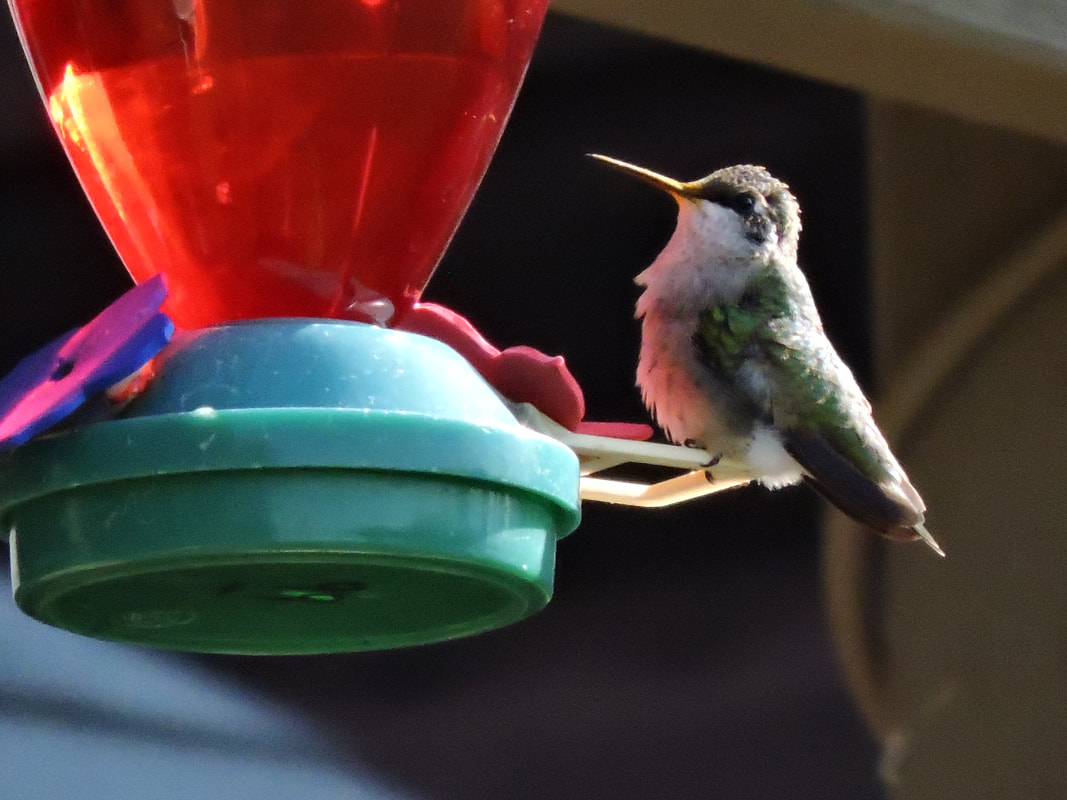 I never like to have a young hummingbird show up in my yard and then leave without learning the feeders. The reason I say this is because when a hummingbird learns a feeder, its drive and desire to return to that same food source increases substantially. One feeder can contain more nectar than an entire garden, and it's all condensed into one handy little package that's neatly laid out right behind a comfortable perch. It's like fine dining for hummingbirds. After most of our hummingbirds left early on the 17th of August, I didn't really expect to have any more really young birds show up. Well, it just so happens that one did. First indication that it was a very young bird was that it spent an enormous amount of time in the flowers. The feeders were open and obvious but had little effect on him. After feeding in the flowers for a little while, he did notice the shiny red object hanging above him. He flew up to it, admired it, and right back into the flowers. He flew to another cluster of flowers, and after feeding for a lengthy time he noticed another beautiful red object nearby. He flew up to it with the same reaction, and right back to the flowers again. The third time was a bit different. He fed at the flowers, noticed the shiny red object, and once again flew up to it. I put training feeders around to connect the young birds to the feeders a little bit easier. This feeder had more realistic flowers instead of the fake looking plastic ones that feeders typically have. These training flowers looked a little more realistic and enticing. He still flew up, somewhat cautious, and slowly proceeded to the flower. He did the quick beak in beak out, and then hesitated for a few seconds while he analyzed the flavor. At that very moment life would be different forever. He clumsily grabbed onto the perch, inserted his bill, and drank until he had a nectar migraine. It would be interesting to read his mind over the next 10 minutes. He drank, pooped, drank, pooped, and continued this for 10 minutes. I kept looking below it to see if my cup was in the line of fire. I couldn't see an expression, but I certainly could see the excitement by his endless indulgence. When he flew, he went to another connecting feeder about 60 feet away. Those fake plastic flowers on the feeder were no longer an issue. He connected the nectar to the red bottle immediately. Now I know that when his time comes to migrate, there's not a chance that he'll pass up another feeder again. Here is just a small bit of evidence he left on the table, very close to my cup. When he left the feeder, I went up to see if my cup runneth over. He did miss it by about 6 inches, but it was evaporating as I captured the image. I would guess this was only half of what he left behind, as he fed there for 10 full minutes. Within a couple more minutes all the evidence disappeared. The proof was in the nectar, and the hummingbird poop was nearly in the cup, but I know for certain he will remain happy as long as he sticks around the garden. Young Ruby-throat hummingbird. N.E. of Edmonton, Alberta, Canada. August 17th, 2019. 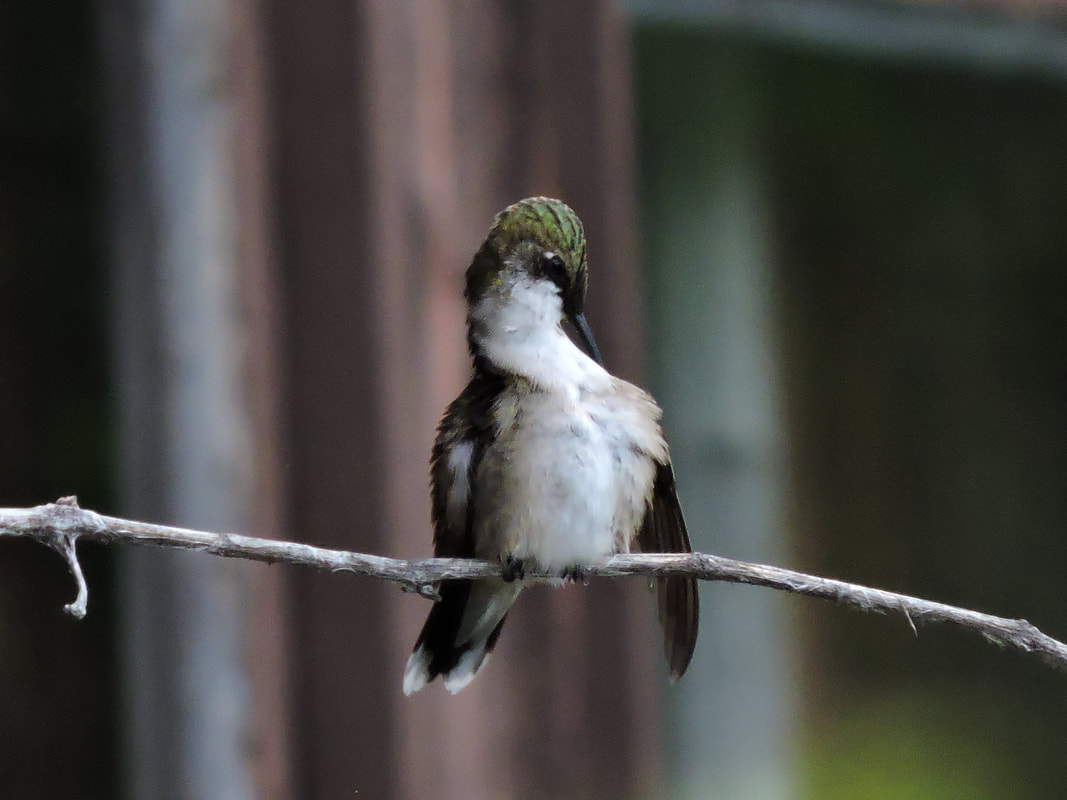 They were given the ability to move like lightning, hover on the wind, remember food sources from years past, and fear less than we do. But their awkward bill, half the length of their entire body, appears to be a mistake by appearance. How is it possible to move with such agility and feed with such precision? I observed and captured a young Ruby-throat as he stretched and contorted his body better than a gymnast. The neck of this young male stretched enough to accommodate the bill length as he poked and preened every location of the body, except the head. Then those almost non-existent feet appeared when necessary to get the locations the bill couldn't reach. It's remarkable how every bird in existence not only has uniqueness and quirks about their appearance, but also the ability to maintain itself with amazing flexibility. From egg to flight in less than 4 weeks, and numerous abilities that are so far beyond our understanding. Not a mistake, not a coincidence, but built to perfection. Juvenile male Ruby-throat hummingbird. N.E. of Edmonton, Alberta, Canada. August 16, 2019. 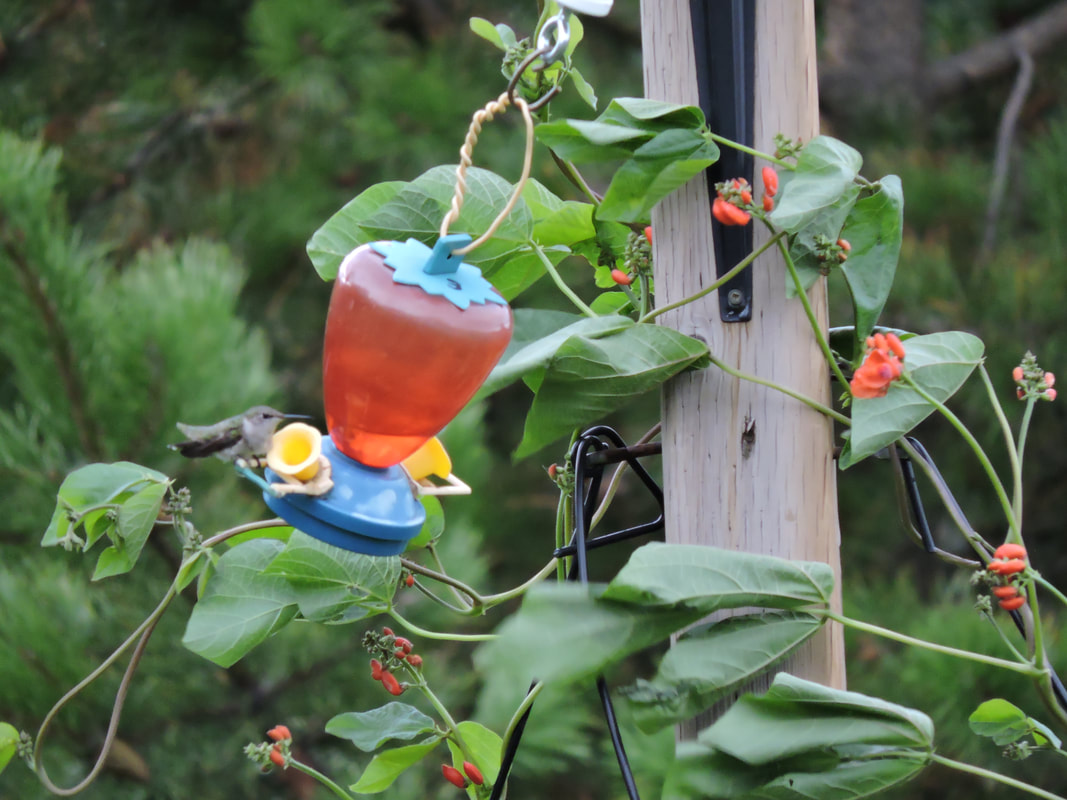 The N.W. winds were howling and most birds had taken shelter, and even though the clapping leaves and branches drowned out the squeaking throughout the garden, the hummingbirds continued to battle. It was as though there wasn't even a wind. The only trouble they had was trying to time their landing on a feeder that was violently swinging in the wind. Once perched, they gripped on tight and rode the wind. The plants turned inside out and leaves were shuttering directly S.E. About 20 hummingbirds still remained in the garden and feeding was a priority. Something was in the wind and the message was very clear to them. It was time to leave. Several took the easy route and rose up into the windy skies and coasted their way in the direction of the Autumn sun while many still remained, and for how much longer was yet to be seen. The next morning I caught the early frenzy, but it didn't last for long. By 7 am the yard had pretty much gone silent. Only about 8 birds remained. They each had a feeder and their was little need to trespass into other feeding territories. The message was still clear for the rest - feed and fatten up because the time is near. The last image is a young male Ruby-throat trying to time his landing. He fought the 70 km wind with little problem, but struggled with the swinging feeder. August 16, 2019. N.E. of Edmonton, Alberta, Canada. 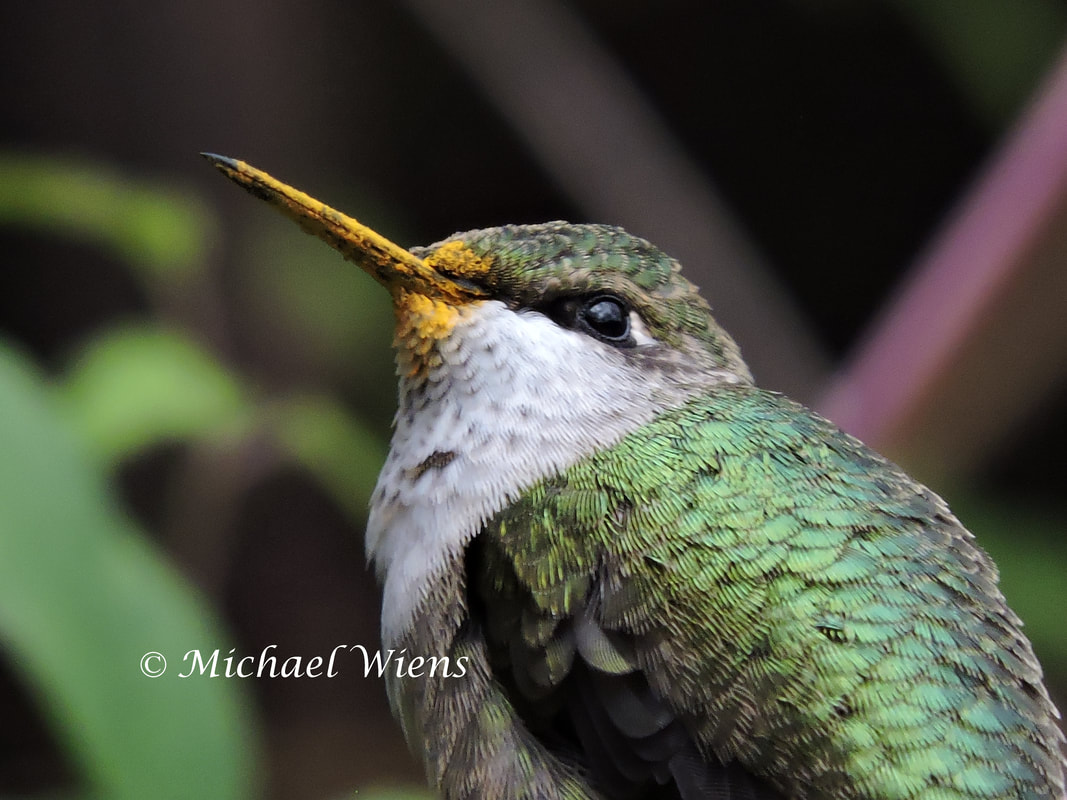 Ziggy, our dominant male Ruby-throat, had come to a point where chasing others out of the garden was no longer necessary. He needed to conserve energy and start fattening up for the long Southern journey ahead. He retreated to one corner of the garden and chose the feeder and flowers closest to him to defend until his departure. He tucked into the Lilac bush and remained there until his next feed 15 minutes later. A youngster appeared in the area where our Nasturtiums were blooming profusely. The young hummingbird clumsily fluttered in and among every flower. Ziggy was nearby and witnessed the whole ordeal. He gave the odd squeak as a warning, but the youngster refused to listen. The color and nectar was far too much to succumb to the warning "chips". The youngster refused to fly away, but instead chose to fly right up to Ziggy and perch one foot away. "Are you my papa?". It was enough to set Ziggy off. He lowered his head, pointed his bill at the little antagonist, and wagged his head back and forth. The little one knew what was coming but chose to disrespect his elder. The reaction of both was at lightning speed. They burst into flight and Ziggy was gonna teach him some respect. A minute later Ziggy returned to his regular perch and waited for his next feed. The youngster still couldn't refuse the Nasturtium nectar, but this time found a perch just a little further away from Ziggy. August 9, 2019. N.E. of Edmonton, Alberta, Canada. Juvenile male Ruby-throat hummingbird. 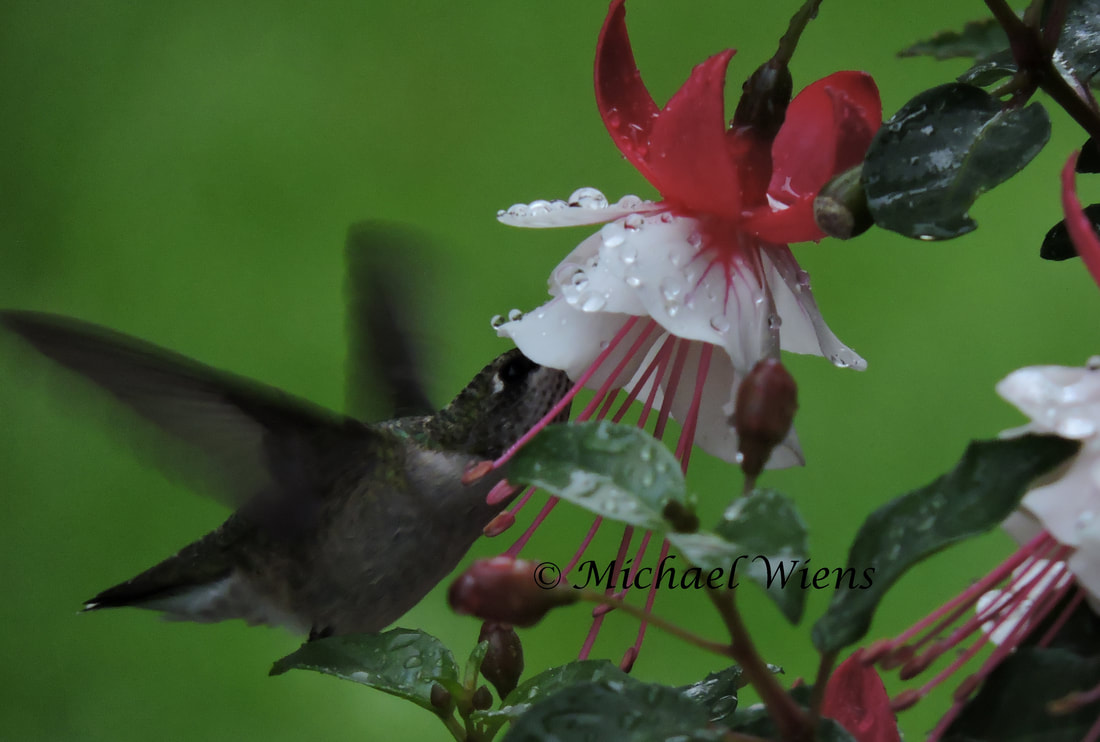 It was very early and the air was filled with the freshness of morning. Rain drops from the night before gripped every flower petal. Silence turned to squeaks as one bird started to "chip", and within seconds all the others woke with a squeak. The chorus of squeaks echoed throughout the garden and in no time at all the inherent fighting began. The night time sleep didn't grant them a good morning with a bright attitude. They were angry as ever and they wanted the world to know it. They instantly flew to the feeder or flowers they owned. It was very difficult to capture great shots so early, but the opportunities were certainly there. This young male Ruby showed up frequently at the Fuchsia flowers, and this is the result. In the low light I managed one capture that stood out from the rest, with rain drops sparkling off the flower petals. Juvenile male Ruby throat hummingbird. N.E. of Edmonton, Alberta, Canada. August 8, 2019. 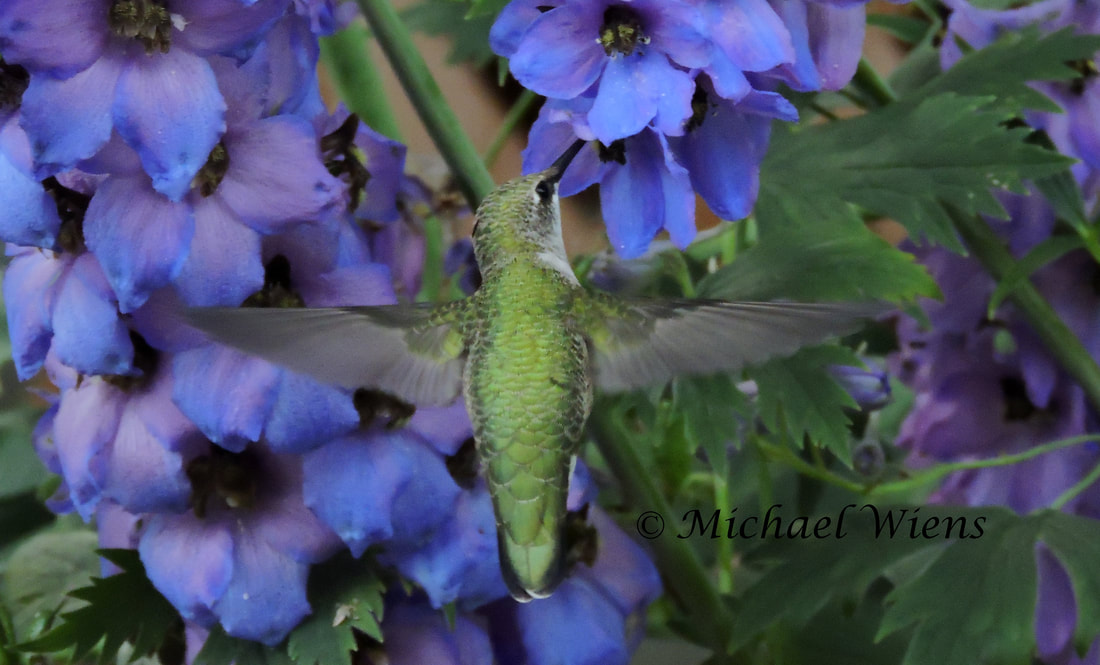 Although hummingbirds have been given the most powerful tool of instinct, their ability to learn is still necessary in figuring out many things they will encounter throughout their lifetime. Simple flowers, such as Zinnias, are an easy poke and taste flower, but some are much trickier. Snap dragons, for instance, need to be pried open, oftentimes seen with bumblebees, but are not often solved or worth the effort by hummingbirds. Every type of flower has its own unique entrance to the sweet nectar, and if hummingbirds want it, they'll need to figure out the access. This is why trumpet shaped flowers are usually the type that very young hummingbirds are first seen at. Once they figure of the entrance to all flowers, they will determine which ones provide the finest nectar. My personal favorite for hummingbirds is Delphiniums. They are a magnet for them. Of all the flowers I've tried and tested, Delphiniums always remain at the top of the list for hummingbirds, even if I have many of their other favorites available. These flowers are not always an option in many other regions, but when you find a flower that is a proven winner, stick with it and go heavy on them throughout your garden. I've just received about 8 young hummingbirds in my garden over the last week. It took until yesterday for all of those young to solve my feeders. If I didn't have a great selection of Delphiniums, or other favorites, those young birds may have moved on without solving the feeders, and once they solve the feeders, they're your's.This is the reason that both flowers and feeders are necessary. Here is one of many captures from just one hour of sitting in the Delphiniums. August 5, 2019. N.E. of Edmonton, Alberta, Canada. Juvenile Ruby-throat hummingbird. |
Archives
June 2024
Categories
All
|
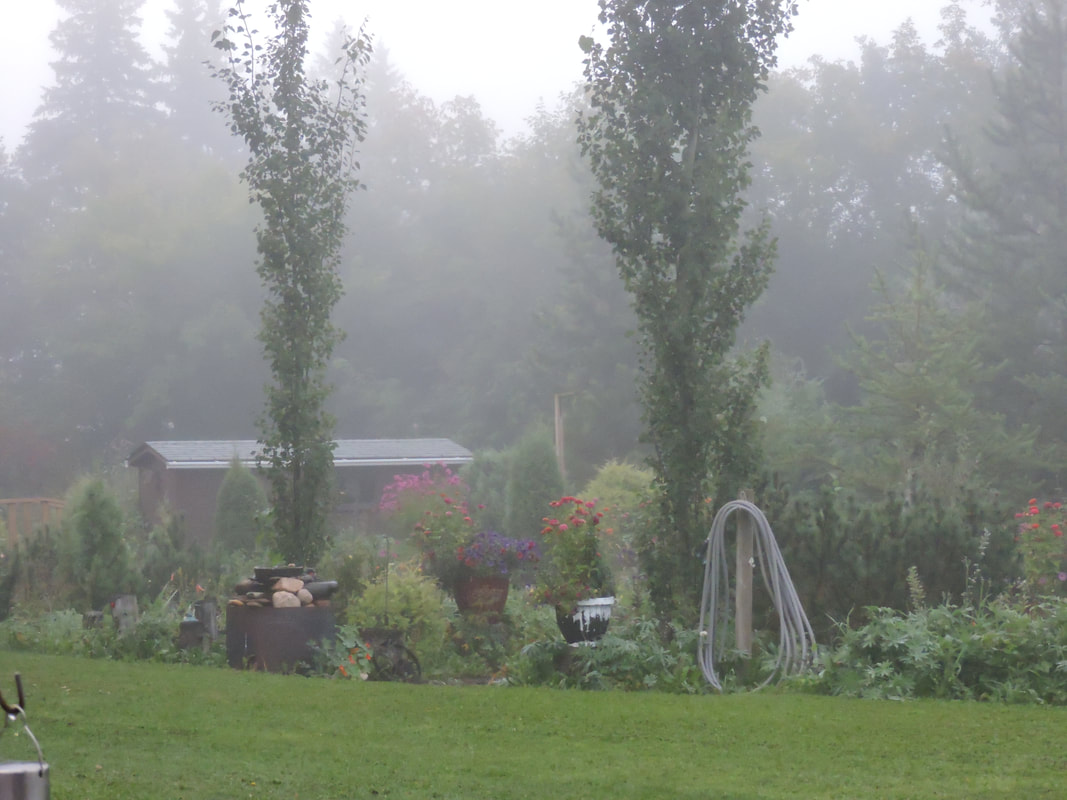
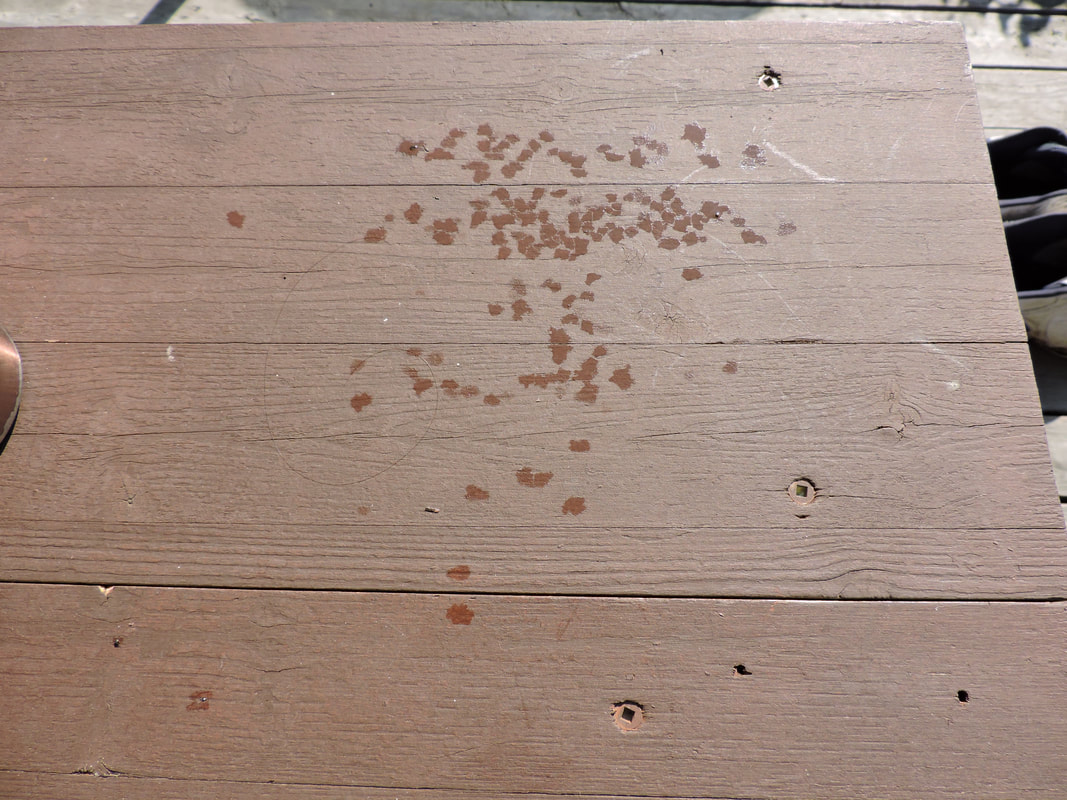
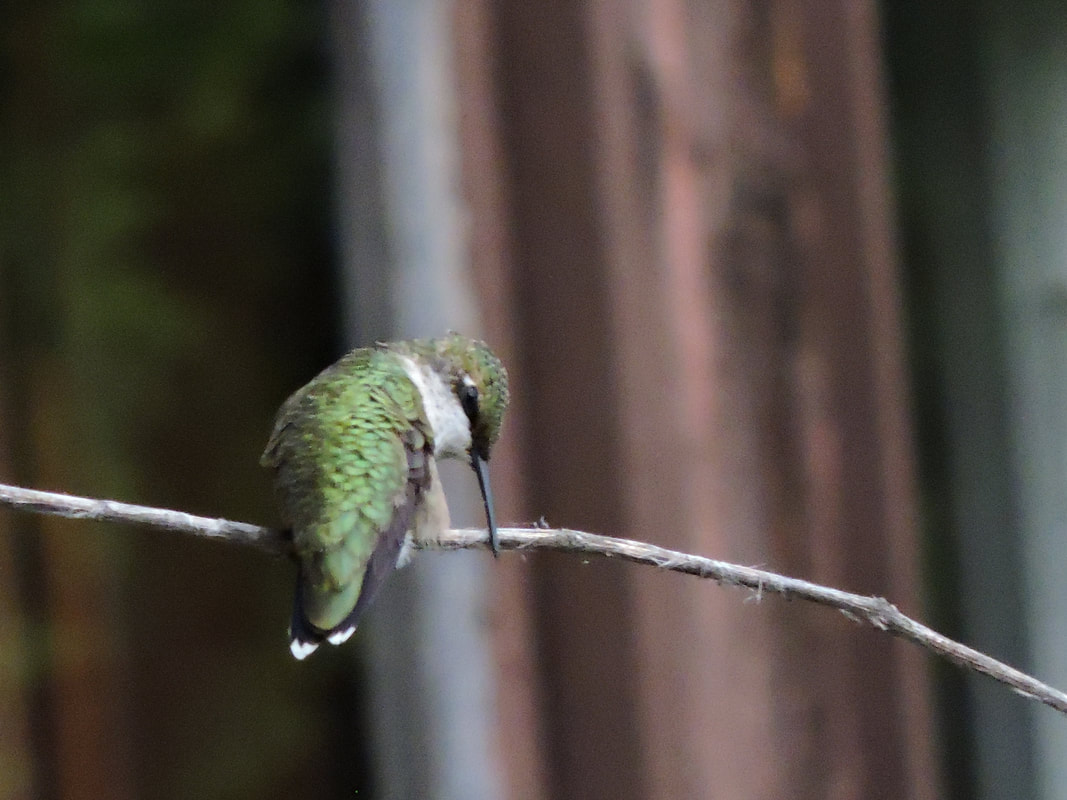
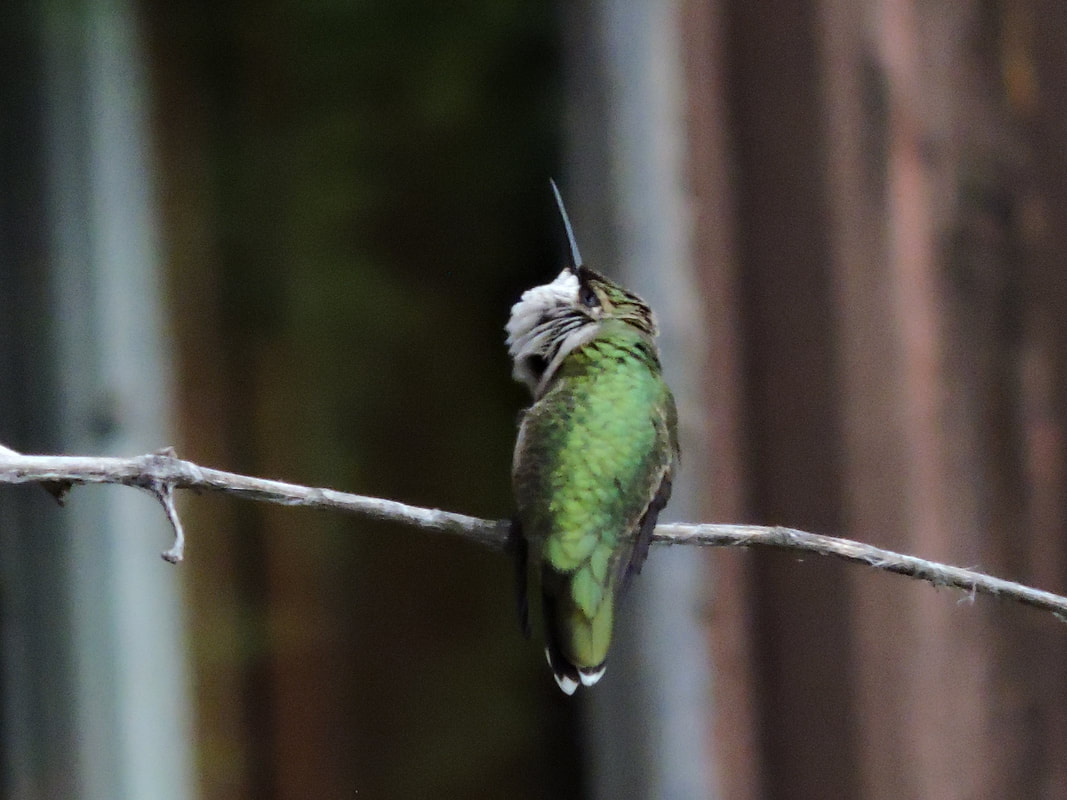
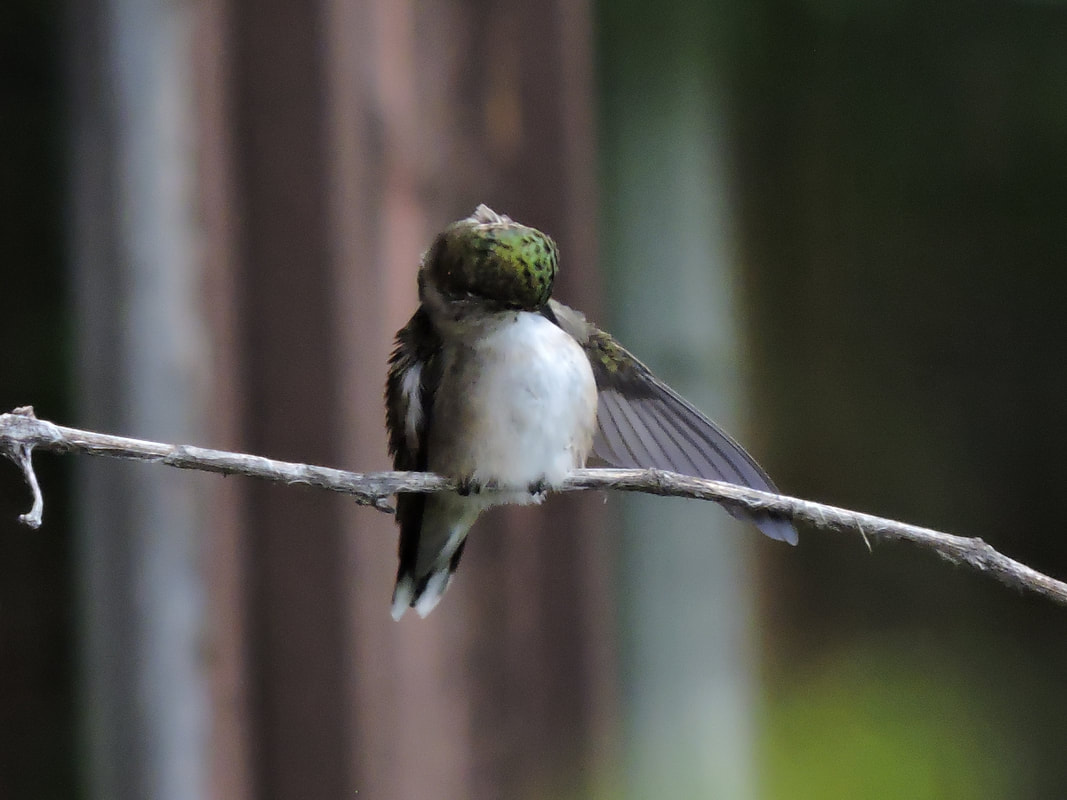
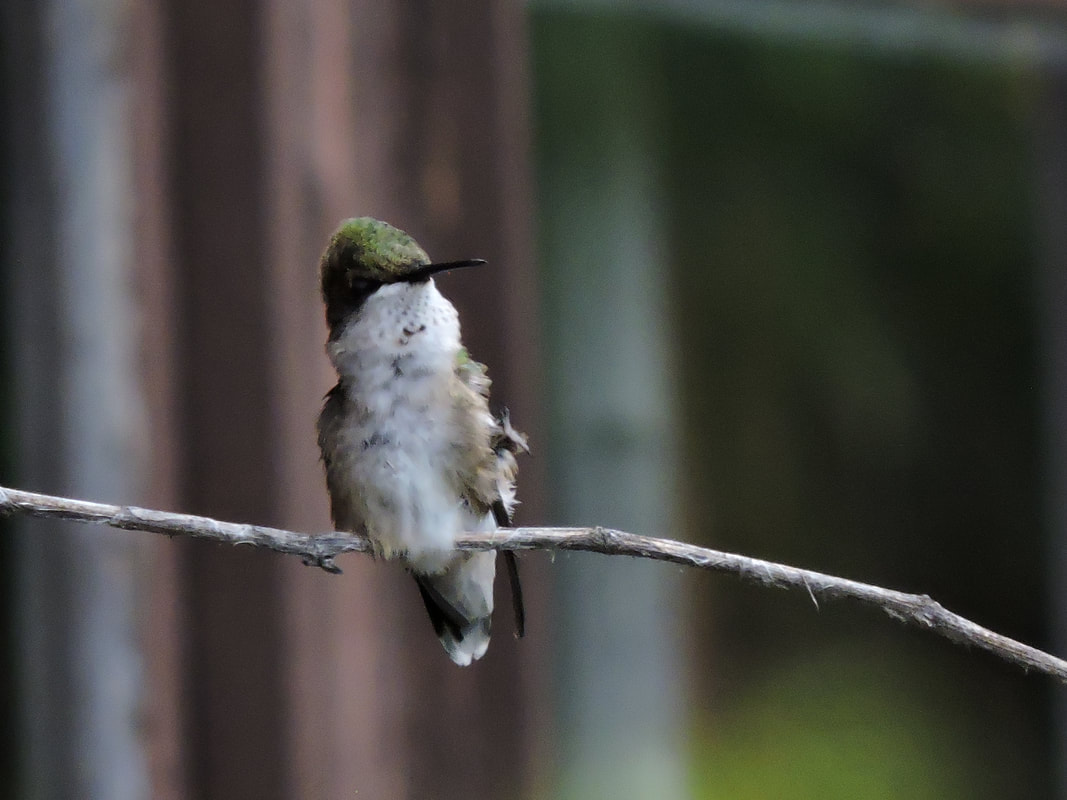
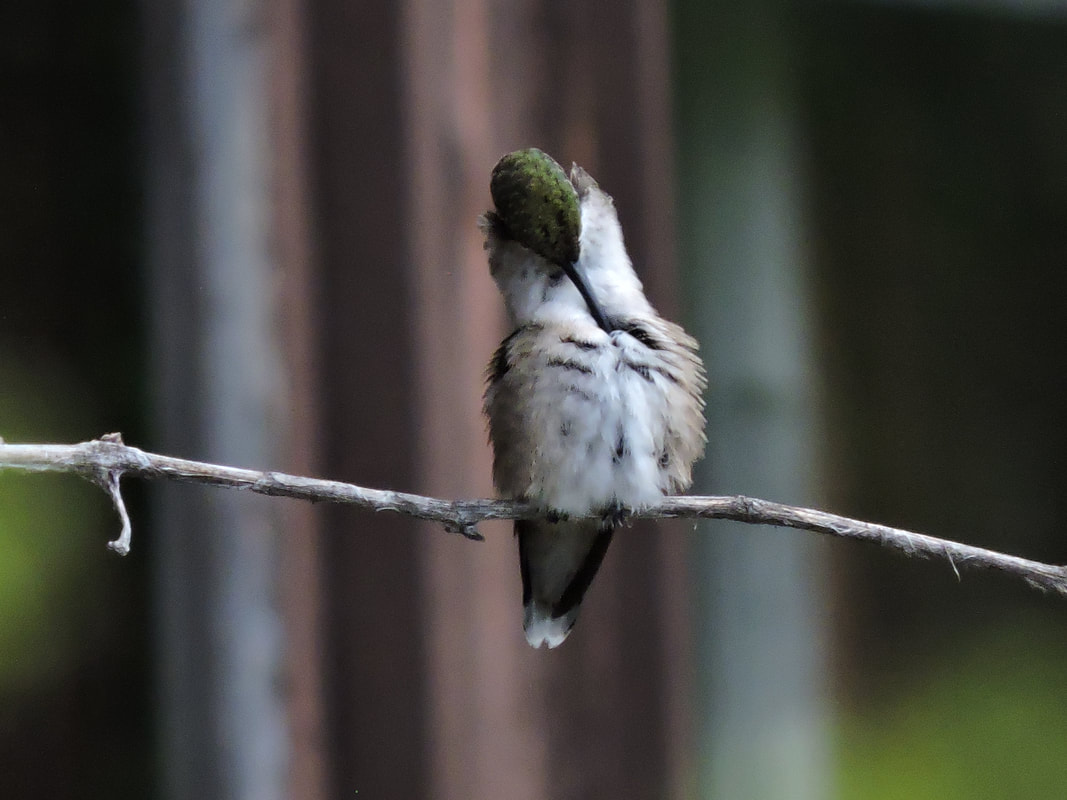
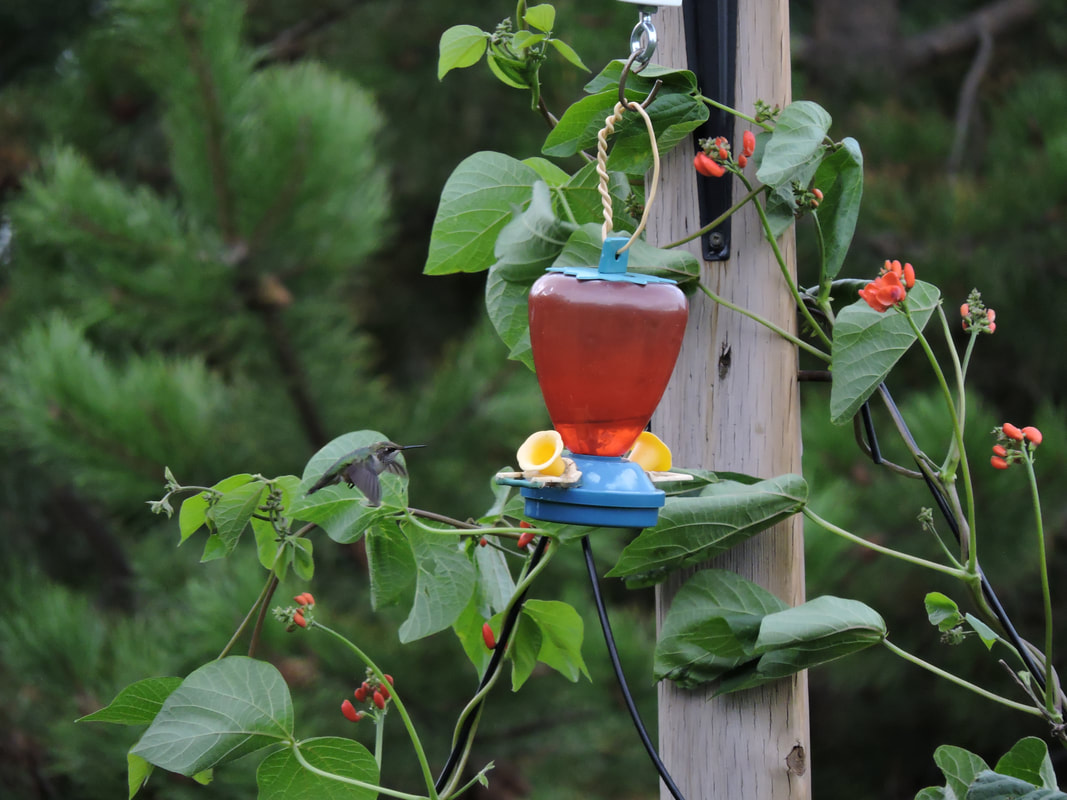
 RSS Feed
RSS Feed
